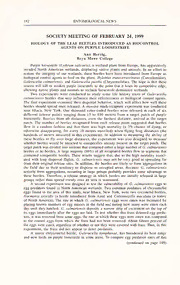
Biology Of The Leaf Beetles Introduced As Biocontrol Agents On Purple Loosestrife PDF
Preview Biology Of The Leaf Beetles Introduced As Biocontrol Agents On Purple Loosestrife
192 ENTOMOLOGICALNEWS SOCIETY MEETING OF FEBRUARY 24, 1999 BIOLOGY OF THE LEAF BEETLES INTRODUCED AS BIOCONTROL AGENTS ON PURPLE LOOSESTRIFE Ann Herzig, Bryn Mawr College Purple loosestrife (Lythrum salicaria), a wetland plant from Europe, has aggressively invaded North American wetlands, displacing native plants and animals. In an effort to restore the integrity of our wetlands, three beetles have been introduced from Europe as biological control agents to feed on the plant, Hylobius transversovittatus (Curculionidae), Galerucelia calmariensis, and Galerucelia pusilla (Chrysomelidae). The hope is that these insects will kill or weaken purple loosestrife to the point that it loses its competitive edge, allowing native plants and animals to reclaim loosestrife-dominated wetlands. Two experiments were conducted to study some life history traits of Galerucelia calmariensis beetles that may influence their effectiveness as biological control agents. The first experiment examined their dispersal behavior, which will affect how well these beetles should spread once released. A massive mark-recapture experiment was conducted near Ithaca, New York. One thousand color-coded beetles were released at each of six different release points ranging from 15 to 850 meters from a target patch of purple loosestrife. Beetles from all distances, even the farthest distance, arrived at the target patch. The number of beetles recaptured from each release point suggested that beetles flew in a random fashion and that there was high mortality (a 3% chance of dying, or otherwise disappearing, for every 10 meters travelled) when flying long distances (the hundreds of meters measured in this experiment). In addition to measuring the ability of these beetles to fly over large distances, the experiment was also designed to measure whether beetles would be attracted to conspecifics already present on the target patch. The target patch wasdivided into sections that contained eithera large numberofG. calmariensis beetles or no beetles. A large majority (86%) ofall recaptured beetles flew to segments that contained conspecific beetles. These results suggest that, due to the high mortality associ- ated with long dispersal flights. G. calmariensis may not be very good at spreading far from their original release sites. In addition, the beetles are likely to form aggregations in the field due to their tendency to disperse to occupied areas. Because G. calmariensis actively form aggregations, occurring in large groups probably provides some advantage to these beetles. Therefore, a release strategy in which beetles are initally released in large groups rather than spread evenly over an area is warranted. A second experiment was designed to test the vulnerability of G. calmariensis eggs to egg predators found in North American wetlands. Two common predators of chrysomelid eggs found in the area of this study, near Ithaca, New York, were two coccinelid beetles, Harmonia axyridis (a beetle introduced from Asia) and Coleomagilla maculala (a native of North America). The rate at which G. calmariensis eggs were eaten was measured by placing known numbers ofegg masses in the field and noting how many were eaten each day until they hatched. G. calmariensis deposits a narrow strip ofexcrement on the top of its eggs immediately after the eggs are laid. To test whether this frass deterred egg preda- tors, it was removed from some eggs; the rate at which these eggs were eaten was compared to the control eggs from which the frass had not been removed. About fifteen percent of the eggs were eaten, regardless ofwhether or not they were covered with frass. Thus, in this experiment, the frass did not appear to deter predators. A native chrysomelid beetle, Galerucelia nymphacae, has broadened its host range and now feeds on purple loosestrife in some areas. To compare egg predation rates of this (continued on page 189)
